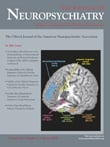Risperidone and Valproate for Mania Following Stroke
To the Editor: Poststroke depression is common. In contrast, mania is rare after a stroke. 1 , 2 We report a case of mania following a stroke with a lesion in the nondominant (right) temporal cortex, which was successfully treated with a combination of risperidone and valproate.
Case Report
Mr. A, a 55-year-old, right-handed man, presented sudden nonfluent aphasia lasting 10 minutes, which was investigated in the emergency department. CT scan revealed focal atrophy in the right temporal cortex. According to the general practitioner and the emergency department, the patient developed mania within 24 hours, characterized by psychomotor agitation, insomnia, a euphoric mood, distractibility, an irritable affect, disorganized thought, denial of illness, and flight of ideas. He had been receiving treatment for hypertension, coronary atherosclerotic vascular disease (chronic stable angina), peripheral arterial disease, and diabetes for 10 years from his general practitioner. His treatment included 10 mg/day of amlodipine, 5 mg/day of trinitrine, and 5 mg/day of glibenclamide. There was no previous personal or family history of psychiatric disorder.
He was admitted to our psychiatric department without his consent 9 days later. He fullfilled the DSM-IV criteria for a manic episode. He was correctly orientated. Cognitively, he scored 28 out of 30 on the Mini-Mental State Examination. B 12 and folates levels were within the normal range. Syphilis serology was negative. A second CT scan showed ischemic focal changes in the right temporal lobe. An angiography revealed a thrombotic stenosis in the right vertebral artery. Mr. A was started on 1000 mg/day of valproate and 2 mg/day of risperidone and had a good response. Over a 15-day period, his elevated mood returned to an euthymic level.
Comment
This case report was characterized by a strong temporal relationship between the neurological symptoms and the onset of the manic episode (24 hours). As in previous studies of poststroke mania, the clinical presentation was the same as for primary mania. 1 , 2 However, since no CT imaging was available prior to the first manic episode, it is not possible to make any definitive conclusions.
Mania and bipolar affective disorder are strongly associated with right hemisphere lesions, particularly in the limbic or limbic-related areas, which have strong connections with frontal lobe, right orbital frontal lobe, basotemporal, basal ganglia, or thalamic lesions. 1 , 2
There is currently no clear consensus about the most effective treatment for poststroke mania. Evans et al. 3 suggested that secondary manic episodes differ from typical bipolar states and are often particularly difficult to treat. This preliminary report suggests that risperidone and valproic acid can be used in the management of secondary mania. Controlled clinical trials are necessary to confirm the efficacy and tolerance of these drugs in the treatment of secondary mania.
1 . Robinson RG: Neuropsychiatric consequences of stroke. Annu Rev Med 1997; 48:217–229Google Scholar
2 . Starkstein SE, Robinson RG: Mechanism of disinhibition after brain lesions. J Nerv Ment Dis 1997; 185:108–114Google Scholar
3 . Evans DL, Byerly MJ, Greer RA: Secondary mania: diagnosis and treatment. J Clin Psychiatry 1995; 56(Suppl 3):31–37Google Scholar



